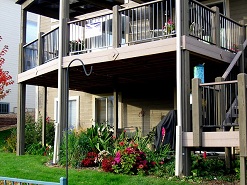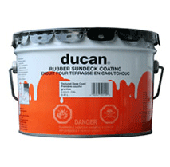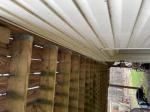Deck Waterproofing Solutions
The topic of waterproofing wood decks can often be an afterthought for the average homeowner.

Are you facing the dilemma of waterproofing an upper story wood deck after it has been built?
It certainly is an easy thing to overlook during the design stage of planning as most people are usually focused on all the great things that will be happening on the deck when it's bright and sunny outside.
It is not until you think about all the potential space underneath your deck that you soon realize it is just wasted space unless it is dry.
Of course, the kind of decks I am referring to are second-level decks with enough useful space below that it makes sense to consider waterproofing the top deck.
This problem is typically with wood and composite surfaced deck boards as in both cases the boards have gaps between them and water drips through to the ground below.
So, where do you begin to fix this potential problem?
Four General Types of Solutions
There are several ways to waterproof a deck.
There are either coatings, membranes, or physical catchment systems like eavestroughs - but much more evolved. Each method has its own benefits and drawbacks.
I am going to talk about four types of waterproofing solutions:
- surface coatings,
- membranes,
- locking deck boards,
- catchment systems or under deck waterproof systems.

Surface Coatings
Just as it sounds you cover the deck surface with a liquid material, and it becomes an impermeable layer. But it won't work directly on gapped boards. You must cover the boards with tongue and groove plywood that have been glued and screwed to the deck.
This is a project the average "DIYer" could handle because the skills and funds required are minimal.
The types of surface coatings you will find most often are liquid rubber products, fiberglass resins, matting, and in some professional circles, cement-based liquids.
For a much more detailed discussion see this article on deck coatings.
Waterproof Membranes
Membranes are solid sheets of waterproof material that are adhered down onto surfaces much like they do in the flooring industry. The decking industry now uses a lot of durable vinyl flooring which originated in the boating industry to seal the inside deck of a boat as it is also a perfect way to seal wood surface decks.
Again, a plywood substrate must be used. So, its a bit more challenging because the welding is critical. Therefore, not necessarily the easiest job for a DIYer.
If you see this as an option, you should read these articles on vinyl membrane solutions.
Locking Deck Boards
Another proven concept is to use extruded aluminum planks that replace wooden boards. These extrusions lock together and have a textured, or profiled surface which stops water from dripping down and, if the slope is correct, channels it to the perimeter of the deck.
Aluminum waterproof solutions also offer you some of the longest lasting decking solutions possible. So, you solve two solutions at once. Not bad!
Here are the top options in this category that come to mind:
Under Deck Systems
Thankfully, some very talented people have spent a lot of time working out all the details of making a second level wood deck waterproof. They all focus on physically catching water under the deck with panels that act like a large eaves trough.
The runoff water is channeled to another trough that takes the waters to a downward spout.
Here are the ones that first come to mind for me:
These products really turn all the space under your deck into a dry useful living space. And they can be easily added on to an existing deck as a retrofit.
Think of the utility you will gain by covering the area above you with a waterproof deck surface while maintaining the beauty of a traditional wood framed decking surface.
We Just Scratched The Surface
There is so much more to learn about deck waterproofing. These detailed articles.
For example, if money is tight then your best material for the deck boards is likely going to be pressure treated lumber. By reviewing the following pieces of additional information, you will have a broader understanding of the latest deck materials available today and be in a position of knowledge to make the best choice for your needs.
Some Other Great Resources:
Home > Deck Waterproofing



























